An NFκB-dependent mechanism of tumor cell plasticity and lateral transmission of aggressive features
- PMID: 29928478
- PMCID: PMC6003573
- DOI: 10.18632/oncotarget.25465
An NFκB-dependent mechanism of tumor cell plasticity and lateral transmission of aggressive features
Abstract
Breast cancer is a complex disease exhibiting extensive inter- and intra-tumor heterogeneity. Inflammation is a well-known driver of cancer progression, often attributed to immune cells infiltrating the tumor stroma. However, tumor cells themselves are capable to secrete a variety of inflammatory molecules, of which we understand very little about their role in intra-clonal communication. We recently reported the capacity of triple negative cell lines to induce a cancer stem cell (CSC)-like phenotype and invasion properties into luminal cells, a mechanism mediated by pro-inflammatory cytokines that up-regulated the CXCL12/CXCR4/CXCR7 chemokine signaling axis. We performed transcriptional array analyses of CSCs-associated genes and cancer-inflammatory cell crosstalk genes and built regulatory networks with the data collected. We found a specific molecular signature segregating with the induced-invasive/stemness phenotype. Regulatory network analysis pointed out to an NFκB transcriptional signature, active in aggressive triple negative cells and in induced-invasive/CSC-like luminal cells. In agreement, NFκB inhibition abolished the induction of the stemness/invasive features. These data support an NFκB dependent mechanism of intra-clonal communication responsible for tumor cell plasticity leading the acquisition of cancer aggressive features. Understanding the communication between different tumor clones would help to find better therapeutic and prophylactic targets to prevent BrC progression and relapse.
Keywords: Intra-tumor heterogeneity and intra-clonal communication; NFκB and STAT signaling pathways; cancer stem cells; invasion; tumor aggression.
Conflict of interest statement
CONFLICTS OF INTEREST The authors declare that they have no conflicts of interest.
Figures
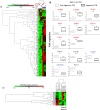
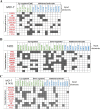
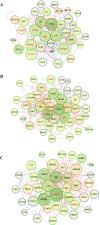

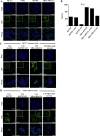

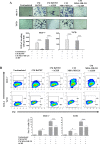
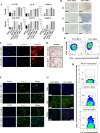
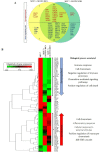
Similar articles
-
Evidence of lateral transmission of aggressive features between different types of breast cancer cells.Int J Oncol. 2017 Nov;51(5):1482-1496. doi: 10.3892/ijo.2017.4128. Epub 2017 Sep 19. Int J Oncol. 2017. PMID: 29048610 Free PMC article.
-
Metastatic neuroblastoma cancer stem cells exhibit flexible plasticity and adaptive stemness signaling.Stem Cell Res Ther. 2015 Feb 20;6(1):2. doi: 10.1186/s13287-015-0002-8. Stem Cell Res Ther. 2015. PMID: 25888913 Free PMC article.
-
Senescence-associated IL-6 and IL-8 cytokines induce a self- and cross-reinforced senescence/inflammatory milieu strengthening tumorigenic capabilities in the MCF-7 breast cancer cell line.Cell Commun Signal. 2017 May 4;15(1):17. doi: 10.1186/s12964-017-0172-3. Cell Commun Signal. 2017. PMID: 28472950 Free PMC article.
-
Enhancement of cancer stem cell susceptibility to conventional treatments through complementary yoga therapy: possible cellular and molecular mechanisms.J Stem Cells. 2012;7(4):261-7. J Stem Cells. 2012. PMID: 24196800 Review.
-
Breast-cancer stem cells-beyond semantics.Lancet Oncol. 2012 Jan;13(1):e43-8. doi: 10.1016/S1470-2045(11)70191-7. Lancet Oncol. 2012. PMID: 22225725 Review.
Cited by
-
Differential impact of classical and non-canonical NF-κB pathway-related gene expression on the survival of breast cancer patients.J Cancer. 2019 Aug 28;10(21):5191-5211. doi: 10.7150/jca.34302. eCollection 2019. J Cancer. 2019. PMID: 31602271 Free PMC article.
-
Cell plasticity modulation by flavonoids in resistant breast carcinoma targeting the nuclear factor kappa B signaling.Cancer Metastasis Rev. 2024 Mar;43(1):87-113. doi: 10.1007/s10555-023-10134-x. Epub 2023 Oct 4. Cancer Metastasis Rev. 2024. PMID: 37789138 Free PMC article. Review.
-
Design, synthesis and evaluation of pyrrolobenzodiazepine (PBD)-based PROTAC conjugates for the selective degradation of the NF-κB RelA/p65 subunit.RSC Med Chem. 2025 May 8. doi: 10.1039/d5md00316d. Online ahead of print. RSC Med Chem. 2025. PMID: 40443648 Free PMC article.
-
Development and characterization of a recombinant silk network for 3D culture of immortalized and fresh tumor-derived breast cancer cells.Bioeng Transl Med. 2023 May 11;8(5):e10537. doi: 10.1002/btm2.10537. eCollection 2023 Sep. Bioeng Transl Med. 2023. PMID: 37693069 Free PMC article.
-
Dynamical modeling predicts an inflammation-inducible CXCR7+ B cell precursor with potential implications in lymphoid blockage pathologies.PeerJ. 2020 Sep 29;8:e9902. doi: 10.7717/peerj.9902. eCollection 2020. PeerJ. 2020. PMID: 33062419 Free PMC article.
References
-
- Bray F, Ren JS, Masuyer E, Ferlay J. Global estimates of cancer prevalence for 27 sites in the adult population in 2008. Int J Cancer. 2013;132:1133–45. https://doi.org/10.1002/ijc.27711. - DOI - PubMed
-
- Ferlay J, Soerjomataram I, Dikshit R, Eser S, Mathers C, Rebelo M, Parkin DM, Forman D, Bray F. Cancer incidence and mortality worldwide: sources, methods and major patterns in GLOBOCAN 2012. Int J Cancer. 2015;136:E359–86. https://doi.org/10.1002/ijc.29210. - DOI - PubMed
-
- Vargo-Gogola T, Rosen JM. Modelling breast cancer: one size does not fit all. Nat Rev Cancer. 2007;7:659–72. https://doi.org/10.1038/nrc2193. - DOI - PubMed
-
- van 't Veer LJ, Dai H, van de Vijver MJ, He YD, Hart AA, Mao M, Peterse HL, van der Kooy K, Marton MJ, Witteveen AT. Gene expression profiling predicts clinical outcome of breast cancer. Nature. 2002:415. https://doi.org/10.1038/415530a. - DOI - PubMed
-
- Kwa M, Makris A, Esteva FJ. Clinical utility of gene-expression signatures in early stage breast cancer. Nat Rev Clin Oncol. 2017;14:595. https://doi.org/10.1038/nrclinonc.2017.74. - DOI - PubMed
LinkOut - more resources
Full Text Sources
Other Literature Sources

